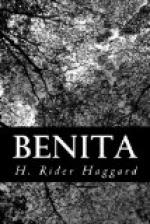Like every other passage in this old fortress, the approach to the cave was narrow and winding; presumably the ancients had arranged them thus to facilitate their defence. After the third bend, however, Benita saw a light ahead which flowed from a native lamp lit in the arched entrance. At the side of this arch was a shell-shaped hollow, cut in the rock about three feet above the floor. Its appearance seemed familiar to her; why, she was soon to learn, although at the moment she did not connect it with anything in particular. The cave beyond was large, lofty, and not altogether natural, for its walls had evidently been shaped, or at any rate trimmed, by man. Probably here the old Priests had established their oracle, or place of offering.
At first Benita could not see much, since in that great cavern two lamps of hippopotamus oil gave but little light. Presently, however, her eyes became accustomed to the gloom, and as they advanced up its length she perceived that save for a skin rug upon which she guessed the Molimo sat at his solitary devotions, and some gourds and platters for water and food, all the front part of the place appeared to be empty. Beyond, in its centre, stood an object of some gleaming metal, that from its double handles and roller borne upon supports of rock she took to be some kind of winch, and rightly, for beneath it was the mouth of a great well, the water supply of the topmost fortification.
Beyond the well was a stone altar, shaped like a truncated cone or pyramid, and at some distance away against the far wall, as she dimly discovered by the lamp that stood upon the altar, cut in relief upon that wall indeed, a colossal cross to which, vigorously if rudely executed in white stone, hung the image of Christ crucified, the crown of thorns upon His drooping head. Now she understood. Whatever may have been the first worship to which this place was dedicated, Christians had usurped it, and set up here the sacred symbol of their faith, awful enough to look upon in such surroundings. Doubtless, also, the shell-shaped basin at the entrance had served the worshippers in this underground chapel as a stoup for holy water.
The Molimo lifted the lamp from the altar, and having adjusted its wick, held it up in front of the rood before which, although she was no Catholic, Benita bowed her head and crossed herself, while he watched her curiously. Then he lowered it, and she perceived that on the cemented floor lay great numbers of shrouded forms that at first looked to her like folk asleep. He stepped to one of them and touched it with his foot, whereon the cloth which with it was covered crumbled into dust, revealing beneath a white skeleton.
All those sleepers rested well indeed, for they had been dead at least two hundred years. There they lay—men, women, and children, though of the last but few. Some of them had ornaments on their bones, some were clad in armour, and by all the men were swords, or spears, or knives, and here and there what she took to be primitive fire-arms. Certain of them also had turned into mummies in that dry air—grotesque and dreadful objects from which she gladly averted her eyes.




